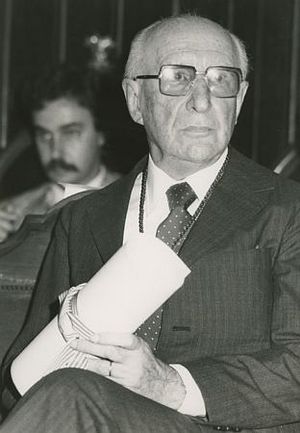Luis Santaló facts for kids
Quick facts for kids
Luis Santaló
|
|
|---|---|
 |
|
| Born |
Luís Antoni Santaló Sors
October 9, 1911 |
| Died | November 22, 2001 (aged 90) |
| Nationality | Spanish |
| Alma mater | University of Hamburg |
| Known for | Blaschke–Santaló inequality |
| Scientific career | |
| Fields | Mathematics |
| Institutions | University of Buenos Aires |
| Doctoral advisor | Wilhelm Blaschke Pedro Pineda |
Luís Antoni Santaló Sors (October 9, 1911 – November 22, 2001) was an important Spanish mathematician. He was known for his work in different areas of geometry.
Life and Education
Luis Santaló was born in Girona, Spain, in 1911. He studied at the University of Madrid. Later, he went to the University of Hamburg in Germany. There, he earned his Ph.D. in 1936. His main teacher was a famous mathematician named Wilhelm Blaschke.
Because of the Spanish Civil War (a big conflict in Spain from 1936 to 1939), Santaló moved to Argentina. In Argentina, he became a professor at several universities. These included the National University of the Littoral, the National University of La Plata, and the University of Buenos Aires. He spent most of his life and career in Argentina.
His Mathematical Work
Luis Santaló worked a lot with his teacher, Wilhelm Blaschke. They studied convex sets. These are shapes that don't have any "dents" or inward curves. Think of a circle or a square; they are convex.
They also worked on something called integral geometry. This part of mathematics uses special tools (called integrals) to measure geometric shapes. It helps to understand how shapes behave in different spaces.
Santaló also wrote many textbooks in Spanish. These books covered topics like non-Euclidean geometry, projective geometry, and tensors. These are advanced topics in geometry that describe different kinds of spaces and how things move within them.
Key Books by Santaló
Luis Santaló wrote many books in both English and Spanish. Here are some of his important works:
Introduction to Integral Geometry (1953)
This book was one of his first major works in English. It explained the basics of integral geometry.
- It talked about how to measure shapes in a flat space.
- It also looked at how to measure shapes on curved surfaces.
- The book included ideas like the isoperimetric inequality. This idea helps you find the largest area you can enclose with a certain perimeter.
Geometrias no Euclidianas (Non-Euclidean Geometries) (1961)
This book explored geometries that are different from the one we usually learn in school (Euclidean geometry).
- It started by looking at the basic ideas of Euclid's geometry.
- Then, it introduced non-Euclidean geometries. These are geometries where some of Euclid's rules, like parallel lines never meeting, are changed.
- The book also covered hyperbolic geometry. This is a type of non-Euclidean geometry where parallel lines can spread apart. It showed how to draw shapes and measure distances in this kind of space.
Geometria proyectiva (Projective Geometry) (1966)
This book focused on projective geometry. This type of geometry studies what happens to shapes when you project them onto a different surface, like shadows.
- The book started with some ideas from abstract algebra. This helps to understand the rules that shapes follow.
- It covered many classic topics in projective geometry. For example, it explained the projective plane and the cross-ratio.
- Santaló also included interesting sections on finite geometry. These are geometries that have only a limited number of points and lines.
- The book had many exercises to help students practice what they learned.
Integral Geometry and Geometric Probability (1976)
This book was an updated and expanded version of his 1953 book on integral geometry.
- It added new ideas and trends in the field.
- For example, it discussed the work of another mathematician, Israel Gelfand. This work involved something called the Radon transform, which is used in things like medical imaging (like CT scans).
Vectores y tensores con sus aplicaciones (Vectors and Tensors with their Applications) (1977)
This book introduced students to vectors and tensors.
- Vectors are mathematical tools that have both a size and a direction (like velocity).
- Tensors are more complex mathematical objects that describe how things change in space.
- The book showed how these tools are used in different areas, including general relativity. This is Albert Einstein's theory about gravity and how space and time are connected.
- It included many exercises to help students understand these complex ideas.
See also
 In Spanish: Luis Santaló para niños
In Spanish: Luis Santaló para niños
- Santaló's formula

